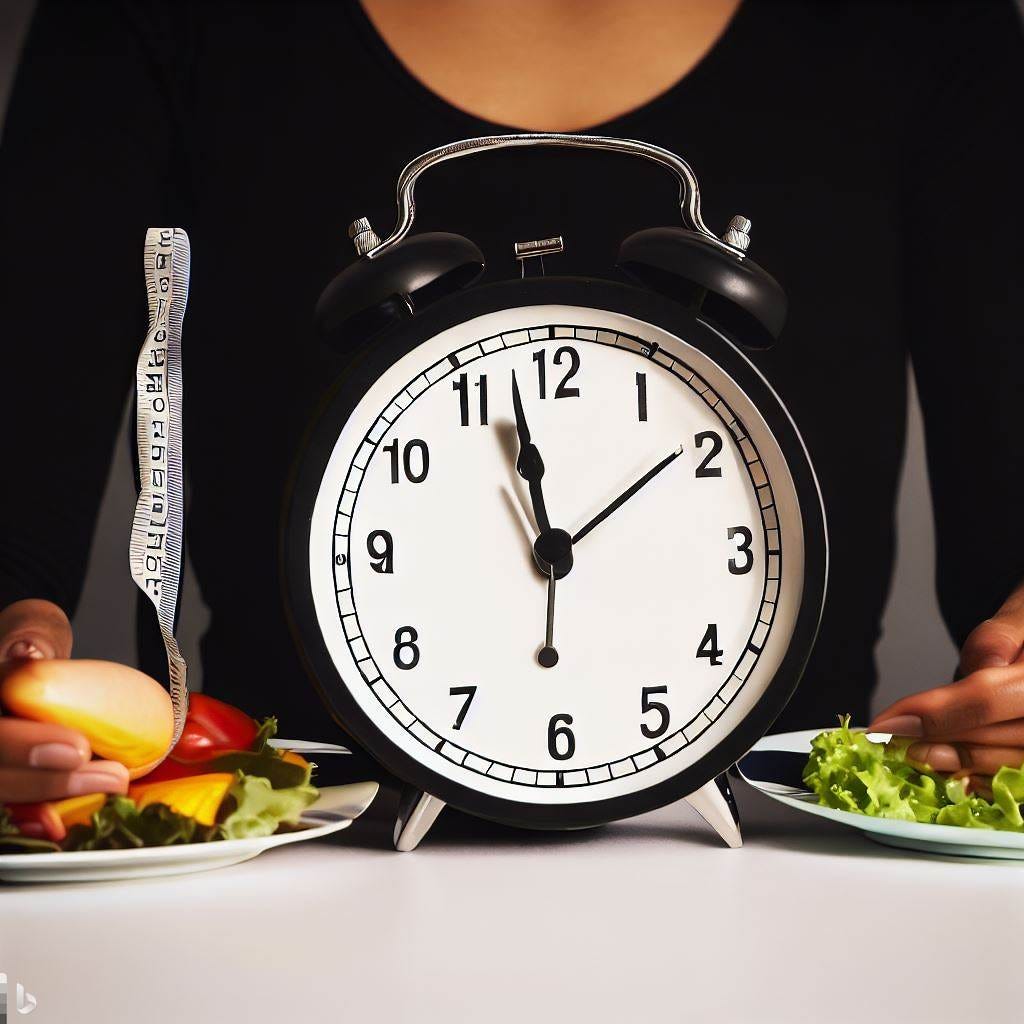Fasting for Better Health
Not only what you eat but when you eat
23 March 2023 is the first day of Ramadhan fasting. Hence, I pick fasting as the public journal topic for this week.
[credit of image generated by AI, Bing Image Creator. A funny story is that most of the clock is fast, and the human eyes generated by the image creator are distorted.]
Dieting vs Fasting
Many people like to lose weight to be healthy. Actually, if we are healthy, our body automatically loses weight. In Organic Learning (OLO), I share the organic (natural and sustainable) approach to promoting health, eating less pharmaceutical medicine, using natural foods as medicine, and even stop-eating (less is more) as a way to heal our body.
Some people associate ‘fasting’ with hungry and suffering (‘hungry’, angry when hungry). I want to share a well-known practice called Intermittent Fasting (IF), which works for me. I am not a medical advisor. I only share my personal journal in this Bear Path public journal about my thoughts and personal experiments for the specific topic. Do consult your medical advisors (if they are genuinely treating people instead of treating disease 医生医病还是医人?)
Dieting
hungry (calorie restriction)
lose less weight in comparison
risk of eating disorder
‘calorie-in-calorie-out’ paradigm. We must eat less to lose weight or exercise more
Fasting
no hunger if you do it right (same or fewer calories but time-restricted eating window)
loss fat
improving health (organs have more extended rest and less inflammation)
Foods contain information besides energy (calories). Food is medicine. It uses hormonal responses as communication to transmit information with the human body (our cells and organs), e.g., insulin
There are many forms of fasting. I focus on intermittent fasting in this context.
The benefits of Intermittent Fasting
burning fat during the absence of insulin and when we need more calories and burning glycogen as fuel for metabolism.
Exercise burns different fat compared to fasting. Fasting is more effective in burning visceral fat
With the presence of insulin, fat, like a warehouse, will only be storing fat (Lipolysis, Glycogenolysis), not burning fat (metabolism).
improve many health markers or reverse some diseases (like fatty liver and autoimmune disease). For the layman, autophagy can rejuvenate or restore our body, make us ‘younger’ (this can motivate you to continue reading …)
fasting promotes AMPK and slows down mTOR. mTOR fosters growth, but overstimulation may be associated with cancer and tumor growth.
AMPK enzyme helps our body maintain metabolic homeostasis, is important for repair by triggering autophagy, mitophagy, and xenophagy, and protects our body by removing intercellular pathogens
allowing digestive organs to rest (not eating all the time), helps promote a healthier microbiome in our guts, and reducing inflammation
Fasting promotes mitochondria uncoupling, this is interesting learning how the presence of ketone and choleric deficit cause mitochondria to self-preserve, and be less ‘productive’ of energy (ATP). Mitochrodia will recruit and work together with other mitochondria to generate more heat (leaking heat). The side effect is the ‘beiging’ of white fat becomes more brown fat
fasting is free (no medicine required), and there are not many side effects
more time with less meal preparation if you skip a meal every day. That could save you 40 days in a year without having to prepare and eat one meal. This is like giving us 10% extra waking days to be alive
Interesting Learning about IF
Breakfast is not the morning meal but the first meal after our fasting, when we ‘break’ fast.
16-8. The 8 hours eating window for the popular intermittent fasting pattern is not carved in stone. The 8 hours windows originated from laboratory mice test where the working hours of the scientists are 8 hours, so much about work-life balance that impacted the golden advice of 168, 8 hours eating window.
Some people may not be suitable for a prolonged fast. If you are on a low-carb diet and taking glucose regulation supplements like Metformin or Berberine, there is a risk of having severe migraine or hypoglycemia when the blood sugar is too low.
Deciding when to eat or what to eat if you are practicing, IF is another exciting topic.
How many meals during the eating windows?
One Meal A Day (OMAD). I am not a fan of OMAD because I have to squeeze the entire day’s calories into a single meal. Scientific findings show that there is no distinctive advantage of a shorter eating window, like 1 to 4 hours. Buddhist monks practice OMAD, and they do not eat after noon (过午不食).
Two meals. I find this ideal for my food intake, not too much food per meal, and won’t feel as hungry as OMAD means fasting for 23 hours every day.
Multiple meals. This is discouraged because if we snack between the main meals, the insulin in our blood remains high.
What time do you eat? What is the ideal feeding window? Scientists have conducted many experiments, and I encourage everyone to conduct their own. Here are a few general guidelines from the studies I used to decide my IF pattern.
The general consensus is to avoid eating 1 hour after waking up and 3 hours before sleeping.
The longer the fasted state, the better.
Overlap the feeding time windows to support social connection so that it is more sustainable. Consistency of IF is more critical than how extreme you fast (OLO: organic means sustainable).
Hence my personal IF is eating around 1pm-7pm. Break Fast at noon and light dinner in the late afternoon. I sleep at 10pm.
Others may choose to ‘break fast’ in the morning, have lunch, and skip dinner. This is the best feasting window to get optimum sleep, but it disrupts social life. Some have their feeding windows from 2pm to 5pm. It is all up to personal lifestyle and whether they want to maintain social dining with family and friends.
A few of my Malaysian Muslim friends say they gain weight during the Ramadhan ‘Puasa’ fasting month, which is exciting but not surprising due to Malaysian dietary and cultural habits. Here are a few observations that might be diminishing the fasting benefits.
[credit of Bing Image Creator again]
Ramadhan fast without drinking water during daybreak, so the feeding time window is in the evening, sometimes feasting (‘buka puasa’ with family gatherings) until late at night, going to bed, waking up early before dawn, and breaking fast. This means the effective fasted state is 3 hours after breakfast (e.g. 5am), 8am-7pm (less than 12 hours of fasted state). Autophagy only begins after 14 hours of the fasted state.
For some people, waking up early to have a meal to start the day may mean less sleep and eating immediately after waking up.
I think the biggest disrupter for not losing weight during the fasting month is our Malaysian diet, which is high in sugar (teh tarik with condensed milk, sweet desserts, rose syrup), calorie-dense foods with high fat, inflammatory fried food with high omega 6 and hydrogenated oil, many process foods etc.
Since this is religious fasting, the time and fasting style is fixed. Perhaps we can consider:
eating healthier food choices with more whole food and less sugar, choosing healthier meal preparation ingredients and method
We should eat a heavier breakfast but a lighter dinner so that we can fully digest the evening meal 3 hours before sleep. Good quality sleep is essential. We should sleep early because we need to eat before dawn. We should have a bigger meal to get enough calories for breakfast (1 hour after waking up).
My personal experiment and experience with intermittent fasting:
Reflecting on my personal experiment with the Keto diet in Q1 2020, one of the success factors was that I incorporated Intermittent Fasting (IF) during my keto journey. I am no longer on a strict keto diet after 6 months, but I still do IF most days.
Metabolic flexibility is a new ‘superpower’ for those who practice keto and make their bodies adapt to burning fat as fuel instead of relying solely on glucose. So, it is an unfair advantage for a metabolic flexible person versus an average person going into fasting. The Keto body is like a hybrid car that can burn 2 types of fuels (ketone or glucose). During the fasted state, her body automatically burns fat as fuel, hence feeling less hungry.
I made the mistake of practicing cycling in and out of IF when I purposely take breakfast occasionally. I have learned that if I shift my eating window, the effect is like turning my time zone, and the body takes about 2-3 days to adjust. This new learning is that I shall be as consistent as possible with my fasting window. This means I shall intermittently fast 365 days instead of 340 days a year. (However, some studies indicate that cycling and disrupting our eating time also benefit training our body to be anti-fragile).
When I began skipping breakfast, I brewed bulletproof coffee. The grass-fed butter and MCT oil added to the black coffee gave me extra fat calories as energy, especially the MCT oil for my cognitive power. Now, I just have my Americano or Long Black in the morning, as fat still triggers a bit of insulin response.
LDL will increase a bit but do not worry. Cholesterol is not the cause of cardiovascular disease (another myth). The regular blood test does not differentiate the buoyant big LDL (80%) from the troublesome small LDL (20%).
It is a standard medical treatment to do a 40-day water-only fast with medical supervision; it is a powerful and effective body reset for acute treatment. Many people practice a 3—to 7-day water-only fast regularly. I tried a 3-day fast once a few years ago. It was an interesting experience, but I am not a fan of long-term (prolonged) fasting. The second day was tougher with hunger and cravings, but I was not hungry on the third day.
What kind of food (macro) is better when I break a fast? Fat, protein, and fiber, our body does not process carbohydrates well after fasting (due to gene expression during fasting). For my lunch and dinner, if I like to have sweet potatoes, having the carbs at dinner is better.
I take electrolytes and minerals when I am on low carb and continuous intermittent fasting. I avoid taking electrolytes with artificial sweeteners and choose formulas packaged with trace minerals.




I came across this article just now, it has good information about the mechanism of fasting. https://lifeapps.io/fasting/the-5-stages-of-intermittent-fasting